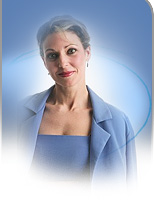
|
 |
| |
 |
 |
|
A breast self-exam
(BSE) is checking your breasts monthly for lumps and other changes. Regular
self-exams will help you learn how your breasts feel. Checking your breasts
will help you find any changes in your breasts from month to month. A professional
caregiver should check your breasts at least once each year.
More women get
breast cancer than any other kind of cancer. The best way to beat breast
cancer is to find it early. Learning how to check your breasts can save
your life. You may not do BSE because you are "too busy" or "don't know
what you are looking for." Some women do not check their breasts because
they are afraid of finding a lump. However, women should know that most
breast lumps or changes in your breasts are not cancer.
Every
woman should check their breasts every month if they are 20 years or older.
The BSE should be done about 1 week after the monthly period because your
breasts are not swollen, lumpy, or tender at this time. At first, you will
find it hard to know what feels normal and what does not feel normal in
your breasts. Regular BSE’s will help you learn how your breasts feel normally
and if something has changed.
If you have had a hysterectomy, check your breasts on the first day of each
month. You should do a BSE at the same time each month if you are pregnant
or have gone through menopause (change of life). BSE should also be done
each month if you have breast implants.
The
following steps teach you how to check your breasts.
- Stand
in front of a mirror with your arms at your sides. Look at each breast
and nipple to check for swelling, lumps, dimpling, scaly skin or other
skin changes. Gently squeeze both nipples and check for discharge (fluid)
coming from them.
- Join
your hands behind your head and look at your breasts in the mirror.
Repeat these steps again with your arms raised over your head.
- You may
find it easier to check your breasts while taking a shower or bath.
Lumps can be felt more easily when your skin is wet. Standing in the
shower or in front of the mirror, put your right hand behind your head.
Use the finger pads of the 3 middle fingers on your left hand to feel
your right breast. The top third of each finger is a finger pad.
- Press
firmly on your breast as you move your fingertips. Ask your caregiver
if you do not know how hard to press. By pressing firmly you will learn
what your breasts feel like most of the time. Check your breasts the
same way every month. Choose one of the following three ways to examine
your breasts. Make sure you touch all areas of your breasts and underarms
during the exam.
- Circle.
Start at the nipple and move your fingertips in a circle around your
breast. Include the area under your arms in this circle.
- Vertical
Strips. Move your fingertips up and down your breast from
the top to the bottom of your breasts. Include the area under your
arms during your exam.
- Wedge.
Picture your breasts like a pie that is cut into pieces. Move your
fingertips around your breast, starting at the top of your breast
and fanning down to the nipple. Remember to examine under your arms.
- Now lie
down and put a pillow or towel under your left shoulder. Put your left
hand over your head. Gently press into the skin of your left breast
using the pads of the middle three fingers of your right hand. Move
your finger pads in a circle, up and down, or like a wedge as you feel
your breast tissue.
- Move
the pillow or towel under your right shoulder. Check your right breast
the same way. Gently use pressure as you move the fingers of your left
hand around your breast. Feel the skin deep in your breasts and the
skin near the top.
- Raise
your left arm and use the pads of your first three fingers of your right
hand to feel in and around your armpit. Do the same thing with the other
armpit.
It is
important that you remember to call your caregiver if you:
- Find
Any Lumps or Changes in Breasts
- Have Breast
Pain or Fluid Coming from Nipples
|
 |

|
For More Information
(419) 226-4500 |
|
|
|

